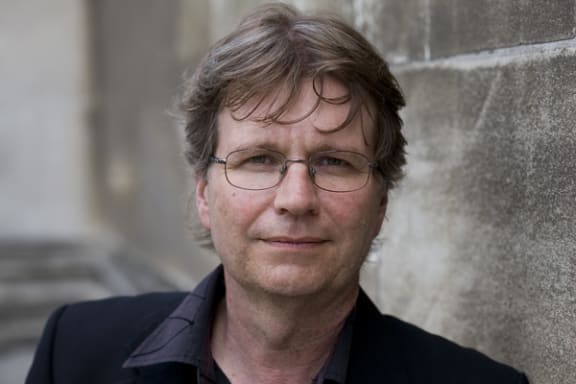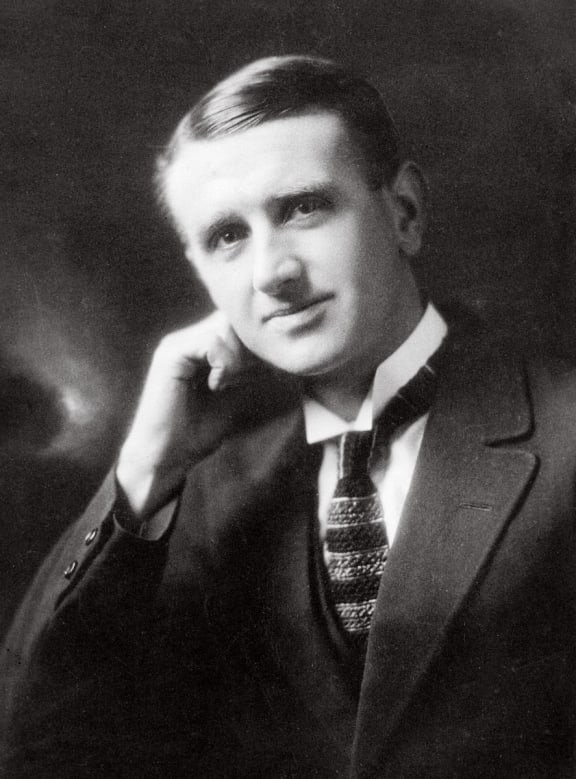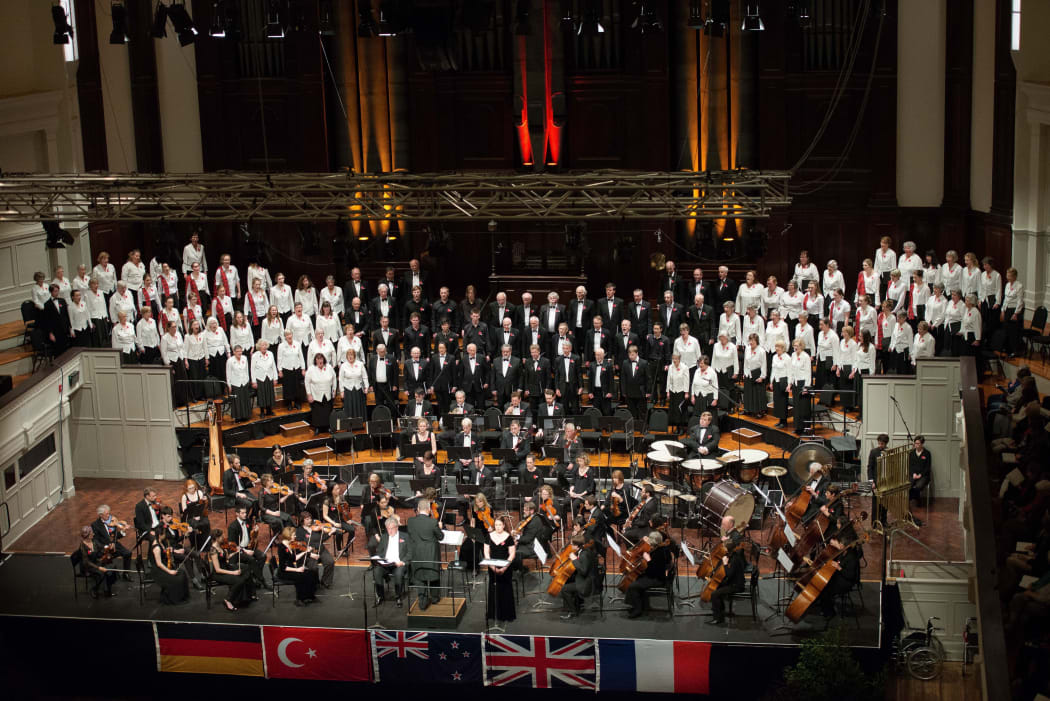This composition topped Settling The Score as New Zealand's favorite piece of classical music in 2020.
Anthony Ritchie's oratorio 'Gallipoli to the Somme' is performed by Anna Leese (soprano), Martin Snell (bass), with City Choir Dunedin, Southern Youth Choir and the Dunedin Symphony Orchestra conducted by Simon Over.
Recorded 1 October 2016 at Dunedin Town Hall by RNZ Concert. Producer: Tim Dodd; Engineer: Darryl Stack
Gallipoli to the Somme - programme note by the composer

Anthony Ritchie Photo: Gareth Watkins / Lilburn Trust / Wallace Arts Trust
How does one create a piece of music commemorating World War I? It is a daunting task, to say the least. There are already many great works that comment on this conflict, Britten’s War Requiem, for one, a piece that I have loved since I was a teenager. This was an anti-war statement that resonated through a generation.
Gallipoli to the Somme is more quietly anti-war, and aims to make a humanist statement about ordinary peoples’ experience of the war. Ordinary people – soldiers, nurses, lovers, children from different nationalities – they are represented in some small way in this work, through diary entries, poems, traditional texts and songs, and even a military plan of battle. It is, of course, not possible to cover every perspective. There are four nations represented in the work: New Zealand, Britain, Germany and Turkey.
The perspective that binds the whole structure together is provided by a soldier, Alexander Aitken, from the Otago Battalion in New Zealand. Aitken wrote a book about his experiences with the same title as this work: Gallipoli to the Somme, published in 1964, many years after the war. Aitken was a remarkable man, a professor of mathematics at Edinburgh University, and also a fine violinist. Peter Fenton’s short outline about Aitken sums up the man far more eloquently than I can do – see following the end of the libretto below.
Therefore, my composition traces Aitken’s journey from his arrival in Gallipoli, his experience of Christmas 1915, his preparation for battle at the Somme, the loss of his comrades, and encounters with the German army. The sound of his solo violin, which he took with him through the war, also pervades the piece. Somehow the violin survived and found its way back to Otago Boys High, Aitken’s old school.
I have used extracts from Aitken’s book (all prose), which are surrounded by a wide variety of other texts, most contemporaneous with the war. There are several poems by soldiers who died during the war, along with traditional song texts with re-composed music. There are even re-compositions of Schubert and Handel, resulting from Aitken experiences and thoughts. One example: at the Somme, Aitken see a sign-post with a finger pointing the direction to the town of Ypres. Even by September 1916 the name ‘Ypres’ was infamous, and reminded Aitken of Schubert’s famous song Der Wegweiser (The Signpost) that contains the ominous line “There’s a road that I must wander / Where no traveller returns.”
The work ends with words by the great Turkish leader Mustafa Kemal Ataturk, taken from the Anzac war memorial in Canberra. This healing text is set to the same music that begins the work, providing a frame for the whole oratorio. Another unifying element in the work is the recurring ‘battle music’ – harsh, relentless, astringent and repetitive. There is no escaping the ugliness of war. The ‘battle music’ uses texts in different languages each time: Maori, English, German, and there is a purely instrumental version featuring the solo violin.
Gallipoli to the Somme – outline of basic structure
Part one - Departing
1. Prelude. Solo violin and strings.
2. E te ope tuatahi (The Angry-Eyed God) – choir.
3. Farewell - Soprano solo. Text by Helen Thomas.
4. The Train – Soprano solo, baritone solo, and choir. Poem by Helen MacKay
5. Journey to Gallipoli - Baritone and choir. Words and a tune by Alexander Aitken.
Part two – Fighting
6. The messenger arrives – Choir. Poem by Pat White.
7. Christmas at Gallipoli, 1915 – Baritone solo and choir. Text by Alexander Aitken.
8. All the Hills and Vales Along – choir. Text by Charles Hamilton Sorley.
9. Peace and War – Baritone solo. Text by Captain Spears, Fifth French Army.
10. Returning We Hear the Larks – Choir. Poem by Isaac Rosenberg.
11. For You but not for Me (The Bells of Hell) – choir. Text: anon.
12. At zero time – Baritone solo. Military plan of battle, Goose Alley, The Somme.
13. Viva la Compagnie! - Baritone solo and choir. Traditional.
14. A German Episode - Baritone solo and Soprano solo. Various texts.
Part three – Grieving
15. Ellen’s Vigil - Solo soprano. Poem by Lorna Staveley Anker.
16. Kemal Ataturk Memorial - Text by Mustafa Kemal Ataturk.
Alexander Aitken – short biography by Peter Fenton

Alexander Aitken Photo: Public Domain
Alexander Craig Aitken was a mathematician whose work continues to be widely influential. His memory and calculative power – non-mathematical talents but suggestive of his genius – are legendary and were present from an early age. But he ‘took off'’, as he put it, in adolescence, consciously building up an immense arithmetic landscape. He was once asked by his children to multiply 123456789 by 987654321. He said, ‘I saw in a flash that 987654321 by 81 equals 80000000001; and so I multiplied 123456789 by this, a simple matter, and divided the answer by 81. Answer: 121932631112635269. The whole thing could hardly have taken more than half a minute.’
Aitken was born on 1 April 1895, in Dunedin, New Zealand. During school holidays he stayed at his grandparents’ farm at Seal Point, and from his wanderings over the Peninsula grew his profound love of the natural world, one of the romantic elements that, merged with other, classical tendencies – mathematics, athletics and music, classical art and literature – produced the vibrancy of his maturity. Music was central to his life. Eric Fenby, Delius's amanuensis, described Aitken as the most accomplished amateur musician he had known.
Aitken entered the University of Otago in 1913, and enrolled in mathematics, French and Latin. With war in Europe, he volunteered on his twentieth birthday and participated in the latter stages of the Gallipoli debacle. He was commissioned in northern France and wounded in what became known as the Battle of the Somme. Invalided home in 1917, he passed a year of recuperative inactivity during which he wrote a draft of the memoir published later as Gallipoli to the Somme (1963). For this work he was elected a Fellow of the Royal Society of Literature (1964).
Aitken resumed his studies in 1918 and in 1919 was elected President of the Students' Association. He graduated with first class honours in languages but a second in mathematics. Bitterly disappointed, he abandoned thought of a career in mathematics and took a job teaching at Otago Boys High School.
In 1920 Aitken married Winifred Betts, a brilliant student of botany who became the first female lecturer at the University of Otago. Contact with R.J.T. Bell, the professor of mathematics at the University, rekindled his ambitions and in 1923 he was awarded a scholarship to study mathematics at the University of Edinburgh. After hurried preparations he and Winifred left New Zealand, never to return.
Aitken’s thesis was completed in 1925, under pressure and at great personal cost. He suffered a breakdown in 1927 that permanently altered his outlook. Referring to it later he wrote: ‘Since that time, there is not a tree, not a turn in the road, not a hill-top, not even a swaying reed, but speaks of the beauty, the terrible beauty and mystery of the world.’ Breakdowns beset him throughout the rest of his life, invariably associated with his experiences at the Somme.
Aitken was appointed to the staff at Edinburgh in 1925, promoted to Reader following his FRS in 1936 and took up the chair of Pure Mathematics in 1948. To an unusual extent he incorporated his extraordinary abilities into a view of humanity that gave primacy to pure being. Despite recurrent illness his natural grace was refined by age. He died on 3 November 1967.

Gallipoli to the Somme concert Photo: Dunedin Symphony Orchestra

